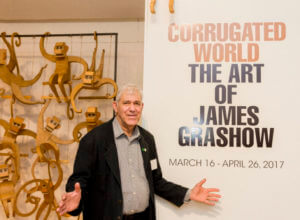
Corrugated World: The Art of James Grashow
By Margot Clark-Junkins, Co-Curator
Tiny houses sprouting from flowers, monkeys, birds, and ceiling-high dancers: what do they all have in common? These playful constructions are made of corrugated board —cardboard— and will be soon be featured in a solo exhibition, “Corrugated World: The Art of James Grashow,” opening March 16, 6-8pm at Flinn Gallery in the Greenwich Library.
A sculptor, printmaker, and illustrator, James Grashow has lived in Connecticut for 40 years. He has exhibited widely at museums and galleries, including DeCordova Sculpture Park & Museum, MassMOCA, Aldrich Contemporary Art Museum, and New Britain Museum of American Art. Grashow’s woodcut prints, which include album covers for high-profile musical groups such as Jethro Tull and the Yardbirds, are also included in the Flinn exhibition.
In preparation for the exhibit, which I am curating with Karen Sheer, we visited the artist in his studio. It was a magical space, filled to the rafters with a veritable menagerie of cardboard creations. An animated speaker, Grashow moved rapidly through the room, talking about his creative process while pointing out certain pieces with pride, running his fingers across their papery surfaces. His giant dancers on wheeled platforms could be rolled around the room. His life-size crane was completely covered in handmade feathers, all of cardboard. There were miniature houses, replete with shutters and shingles. Grashow picked up a woodblock covered with tiny gouge marks, then opened a flat-file drawer to show us the remarkably detailed corresponding woodcut print.
Collector and art dealer Allan Stone, who raised his family in Purchase, represented Grashow for decades, and it was Stone’s daughter, the filmmaker Olympia Stone, who made Grashow the subject of a penetrating documentary, “The Cardboard Bernini” (2012). The film chronicles the creation — and calculated destruction — of Grashow’s largest project, a cardboard replica of Bernini’s great fountain in Rome. The film offers a rare glimpse into the mind of an artist, showing us Grashow’s artistic methods, as well as his hopes, fears, and inspiration. It will be screened in Greenwich Library’s Cole Auditorium March 24 at 8, followed by a Q&A session with the artist. The exhibit runs through April 26.
This also appeared in The Rye Record on March 19, 2017

Credit: Karen Sheer
Interview With James Grashow by Co-Curator Karen Sheer
KS: Karen Sheer
JG: James Grashow
KS: Since Corrugated World: The Art of James Grashow is considered a retrospective of your work, how do you feel seeing all of your creations together at the Flinn Gallery?
JG: A retrospective is a unique opportunity to see my work together. putting the show together became a reflective and emotional journey through my life. You remember where you were with each piece, what you were thinking and how and why each work evolved. You remember not just the thoughts that brought the work into the world but the physical process of doing it. Everyone sees finish, but you remember the whole process, the cutting the lifting the glueing.
You remember the risks that you and your body were willing to take. Seeing part of my body of work together in a fantastic space like the Flinn Gallery has given me the opportunity to see where I’ve been and where I want to go.
KS: Can you explain the difference of artistry/method between your works – Woodcuts, House Plants, Monkeys, Fish and Cardboard Structures.
JG: People make a mistake identifying an artist by the subjects he draws. You can tell who an artist really is by the materials he chooses to work with. An artist that works in steel is a different person than one that works in paper. I choose cardboard. The material reflects how I feel. It speaks on its own about mortality and the transient nature of man.
I’ve alway felt that I have two different sides. The physical part of myself that wants to sweat and feel muscle and the slow contemplative side that wants to slow everything down and work line by line. The woodcuts and houseplants represent that slow side and the corrugated board is the muscle. Work is an incredible stew you throw every part of yourself into and see what comes out.
KS: What are you influenced by?
JG: I am influenced by everything. The profound and the mundane from Rembrandt to Judge Judy. The trick is to learn all you can and still listen to your own voice.
KS: The crowd on opening night seemed amazed of your meticulous detailing – how do you have such patience for such intricate work?
JG: Working on intricately detailed pieces is a very satisfying process. The world shrinks and the chaos becomes manageable. Doing Houseplants or woodcuts, the work becomes a mantra. Like Ghandi weaving, the slow repetitive process settles the mind.
KS: What are you working on next?
JG: I’m working on several large commissions. One a group of eleven ground monkeys that will be cast into bronze. The project will be installed in a fantastic garden in the spring. I’m also building a large aquarium where all the fish are coming out of flowers.
Seeing all the work together has given me a chance to see how the seeds of current work are sown in earlier pieces, I can trace the development of ideas, clearly see the past and anticipate the future.
This also appeared in GreenwichFreePress.com on March 24, 2017
